Last updated: October 1, 2021
Article
Historic Manitou Fish Camp
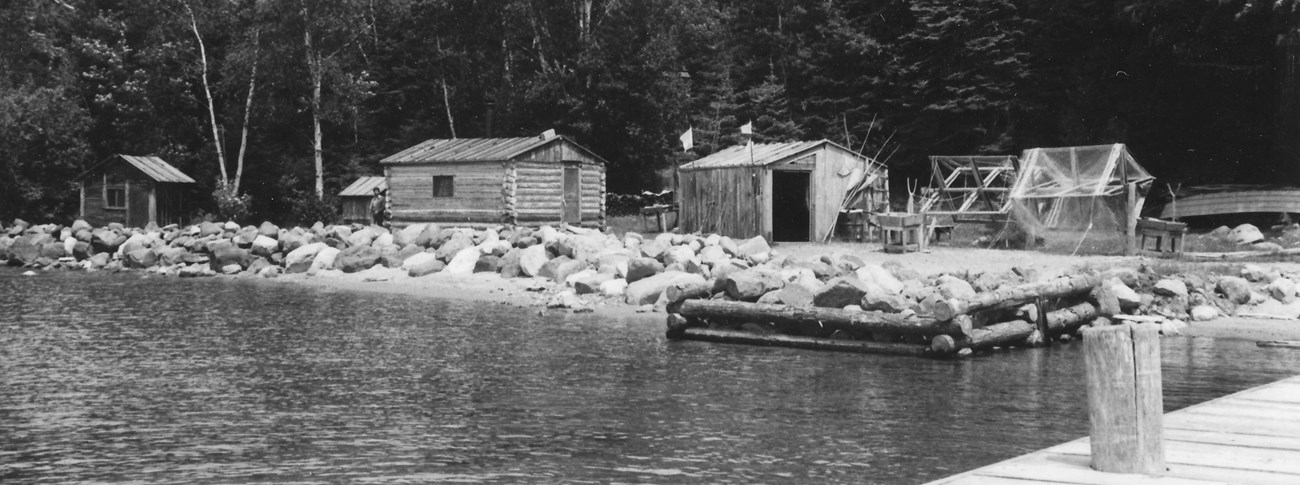
NPS photo
“Pretty tough life, that fishing in the wintertime.”
For centuries, people fished the waters around the Apostle Islands. Traces of their work – fish bones from Native American archeological sites, a decaying net reel on Rocky Island, entire buildings at Little Sand Bay – provide glimpses into these past lives. Manitou Fish Camp tells another of these stories.
An unplanned assortment of rough buildings on the edge of a forested island, Manitou camp never played a major role in the total Bayfield fishing economy. The fishermen here made a daily living, not a fortune. The camp, as it looks today, took shape in the 1930s. In 1938, Hjalmer “Governor” Olson and his brother Ted purchased the land and its then existing structures for $600 from a land company. They sought a place with stable, thick ice for winter fishing.
For the next three decades, this ramshackle camp became a favorite destination for many local men. No one ever considered the camp a permanent residence. Some, like the Olsons, came and went from Manitou throughout the year. Most came to fish in the winter. Men walked to the island and fished through the ice. Some were young and just starting out. Some worked other jobs – plumber, sailor, logger, even a lawyer – but for a variety of reasons, found their way to Manitou. Fishing on Manitou was tough but, because no boat was necessary, demanded little start-up money. It provided a steady income for these men to survive bleak times.
Governor Olson sold the camp in 1964 but retained use of the site until 1983. During this period the Governor’s friends continued to visit, fish, and party at the camp. By then it was more of a hangout than a frontier refuge. In 1983, the National Park Service began restoring the camp to recapture the 1930s appearance.
As your boat pulls away from the island, look back and notice how quickly the site fades into the forest. How small and insubstantial is this place in the vast interplay between the lake and the land… yet this narrow edge provided hospitable shelter when the more substantial comforts of town living were beyond reach, or too confining.
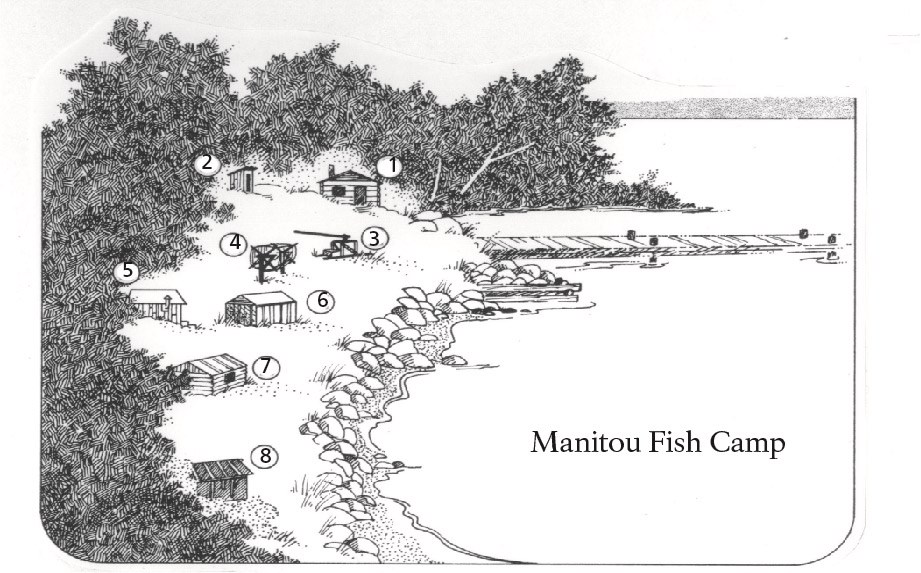
NPS
A Guide to the Fish Camp Structures
According to local fishermen, the appearance of the shacks has not changed much since the 1930s.
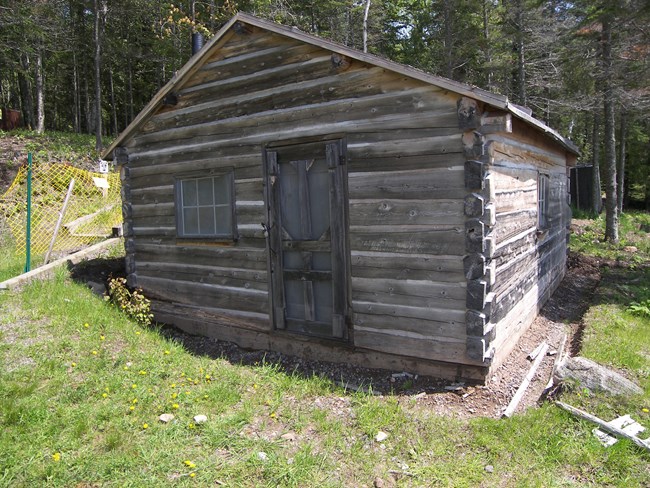
NPS photo: Neil Howk
1. Governor’s Cabin
Built about 1900 by Swedes logging cedar on the island, the cabin was then used by John Hanson who stayed on to fish after the logging was done. Years later, Hjalmer Olson shared this memory of Hanson: “You had to be kind of careful, especially with drinking. He was pretty touchy.” One November day in 1935, Hanson and a companion stopped at an inn north of Bayfield on their way out to Manitou. Olson recalls that they were chased out. “Hanson was pretty drunk… the other fellow, he never knew much about navigating a boat… They sunk out there someplace.”
Hjalmer and his brother moved into Hanson’s cabin when they bought the camp in 1938. Some of Hanson’s things remain in the cabin, including the table near the window, the black iron stove, and the short-legged chair, on which Hanson sat when he was mending nets.
Though called “Governor,” Hjalmer Olson’s nickname had less to do with his authority than with the new suit he wore to a show in Bayfield (provoking a joking response from his friends). Nobody governed the people in the camp; life there was unfettered by social restraints. As Ted Olson said, “We just let them stay there rent free.”
The “Governor” wasn’t the only fisherman on Manitou with a title. “Captain” Gottfried Bark (1881 – 1957) once sailed for the Swedish Navy. He worked as a fisherman and logger on various islands in the 1920s and 30s. In the 1930s on Manitou, he cured herring and venison in the smokehouse.
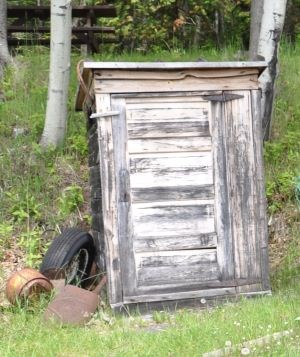
NPS photo: Neil Howk
2. Smokehouse
Originally built by Hanson and used by Olson and others over the years to cure fish and meat. Smoked fish and meat were part of the food supply on Manitou, and usually were not sold. The Governor described how he would build a slow-burning fire and hang the fish upside down, nailed by their tails to narrow slats placed near the top of the shack. Metal sheathing around the base protected the structure from burning.
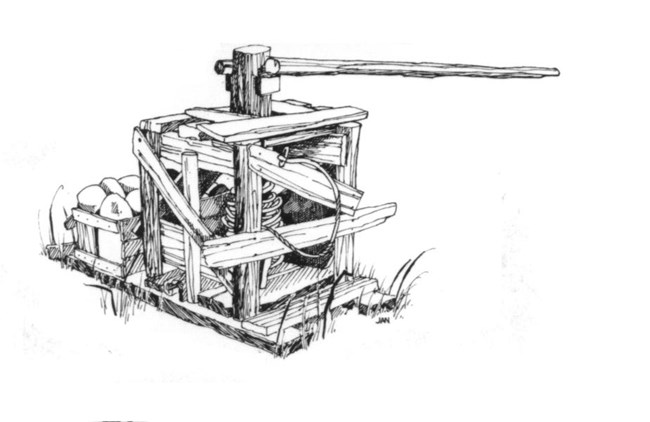
NPS graphic
3. Windlass
“Governor” Olson, a man (as he claimed), “with a weak back but a strong mind,” built this windlass to haul his skiff out of the water in rough weather and before the ice set in. He built it using scavenged materials left behind by loggers and fishermen. (Many years have past since this winch was built or used. Please don’t test its strength today.)
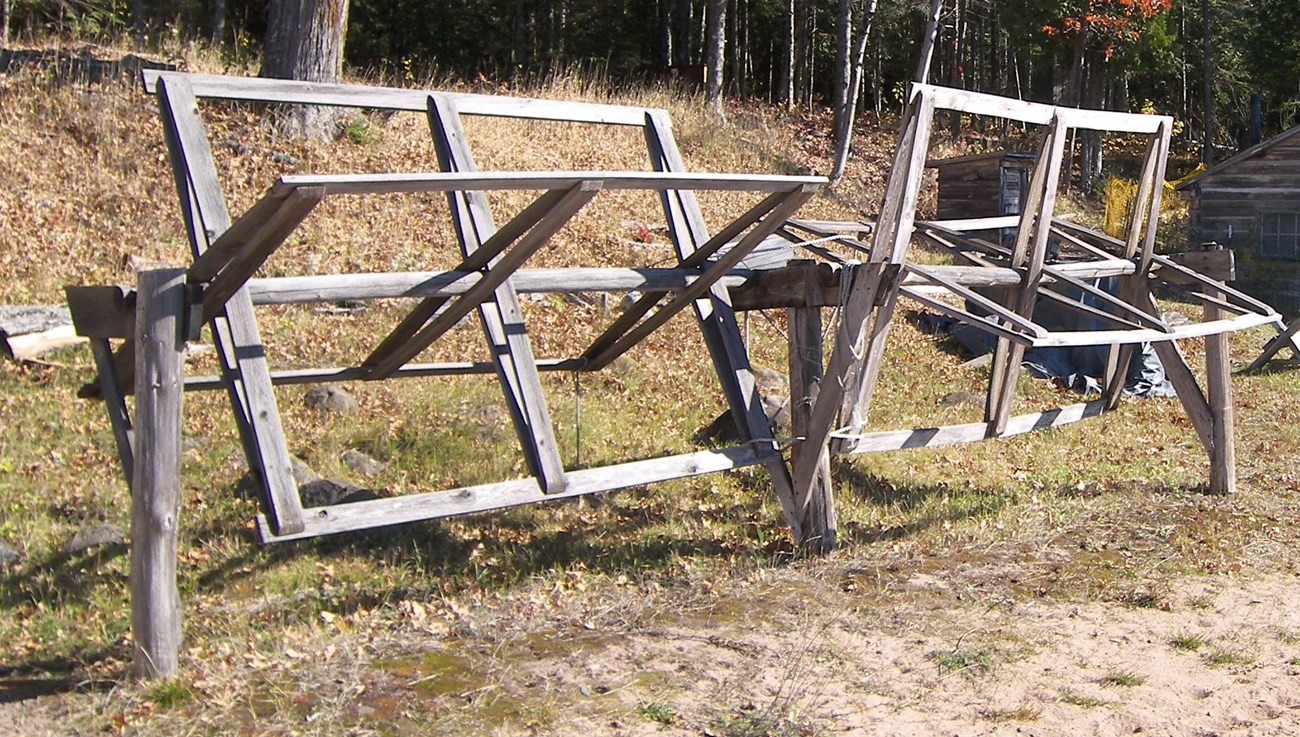
NPS Photo: Neil Howk
4. Net Drying Reel
Some of the fisherman on Manitou used gill nets – fine nets suspended like curtains in the water. Fish too large to slip through the mesh become entangled when they swam into the nearly invisible net. Whitefish and lake trout were the marketable catch.
Before nylon became common, gill nets were made of cotton or linen and would rot if left in the lake too long. Nets were wound on the reel to dry in the sun. Then they were pulled down through the smoothed tree fork into a wooden box, each net arranged so that the mesh coiled in the center of the box and the leads and floats, which took the most space, were on the edge. A careless job would result in hours spent untangling the net.
In the winter, fisherman would chop holes in the ice and use a “running board” and ropes to set their gill nets under the ice.
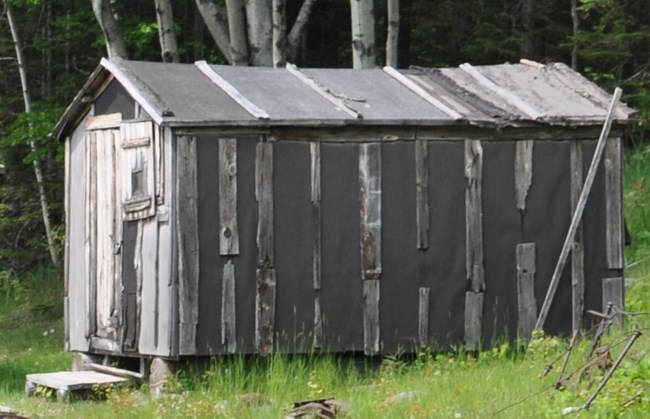
NPS photo: Neil Howk
5. Twine Shed
“And we had this one little cabin sets up against the bank – we used to call that a twine shed, for tools and netting and stuff like that. Always had to have a little cabin to put that stuff in… Lots of stuff you don’t think you need but then it comes in handy.” -Hjalmer Olson
The smaller of the two twine sheds contains a stove, used for both heating and cooking, kitchen utensils, a sled, and a home-made ski pole for crossing the ice. Many of the fishing items were handmade or reconstructed from tools taken from abandoned logging camps on the island.
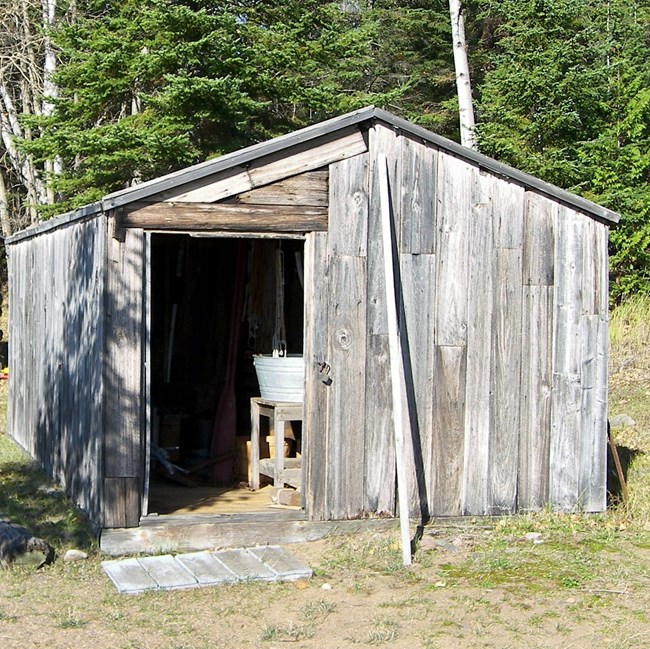
NPS photo: Neil Howk
6. Twine Shed
Along with the cluster of nets and floats draped from the rafters are lures and large, barbed fishhooks dangling from nails in the walls. At Manitou, many of the men fished for lake trout with hooks and lines instead of nets. Simpler and cheaper, “jigging” suited a man who was between jobs and needed a place to stay and something to do.
This twine shed, the larger of the two, was also used as a stable.
In the days before snowmobiles, men hauled their catch to town and their supplies to the island with small wooden sleds that carried 400-500 pounds. This weekly trip across the ice from Manitou to Red Cliff took about three hours.Many fishermen kept one or two large dogs to help pull. Hjalmer Olson also had a horse named Jim. On one trip the ice broke, plunging Jim into the lake. The fishermen couldn’t get him out and he drowned. Jim’s manger is still on the wall in this Twine Shed.
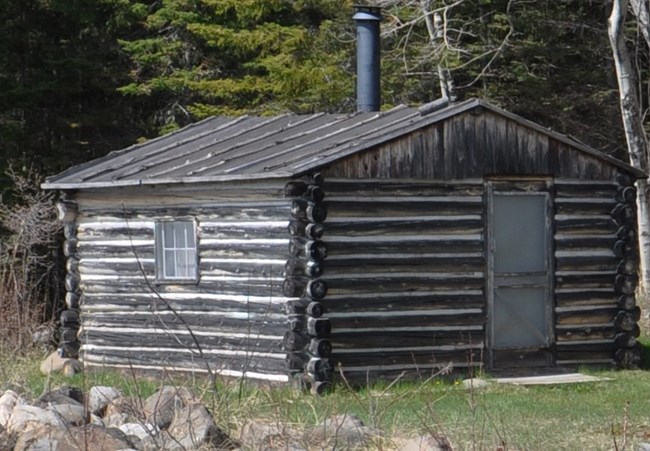
NPS photo: Neil Howk
7. Bunkhouse
Currently used as staff quarters, this was originally built by Ted Olson on Ironwood Island. Dismantled and rebuilt by Ted in the late 1930’s, it provided shelter to local fishermen over the years, including Wilfred Peterson from the Red Cliff Band. In October, he would set gill nets for lake trout spawning on the rocky reefs near the shore. In so doing, he was following a traditional fishing activity that archeologists have dated on Manitou as early as 1640. Studies show that the island was repeatedly occupied by Native Americans who came in the autumn to net trout and whitefish that spawned nearby.
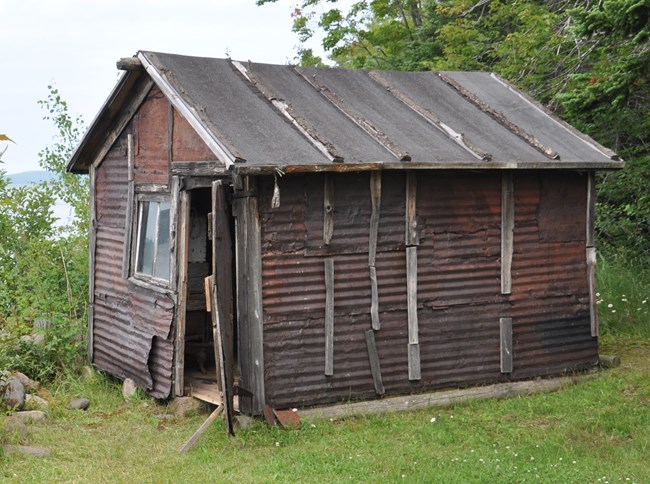
NPS photo: Neil Howk
8. Ice Fishing Cabin
Protected by a covering of corrugated tin, this shed was originally used as a winter fishing cabin, though reportedly it provided little protection from the cold. This cold shack was used for days or weeks at a time by an assortment of men whose names, such as Jingling Johnson and Black Pete, suggest a rough and ready life.
Bob Soulier from Red Cliff stayed there with Captain Gottfried Bark. “It was colder than hell, but we had a fire going all night long. Every hour somebody would get up and throw some wood on the stove.”
“It was snowing and blowing we could hardly go outside. We went in the woods and cut a little wood once in a while. It was just like sand hitting you in the face. I went out to get a bucket of water once in a while.” -Hjalmer Olson
